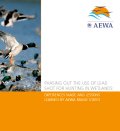On this page
AEWA Popular SeriesThis page lists the English language editions of the popular series publications under the banner of the African-Eurasian Waterbird Agreement (AEWA).The majority of this series can be downloaded from the AEWA website.
AEWA pagesThere are two AEWA related pages on the site:
Technical Series
Popular Series
AEWAAEWA is an intergovernmental treaty dedicated to the conservation of migratory waterbirds and their habitats across Africa, Europe, the Middle East, Central Asia, Greenland and the Canadian Archipelago.Developed under the framework of the Convention on Migratory Species (CMS) and administered by the United Nations Environment Programme (UNEP), AEWA brings together countries and the wider international conservation community in an effort to establish coordinated conservation and management of migratory waterbirds throughout their entire migratory range.
|
|
|
|
Introduced Non-Native Waterbirds: Status within the African-Eurasian FlywaysAlex N. Banks, Lucy J. Wright, Ilya M.D. Maclean, Chris Hann, Mark M. Rehfisch
AEWA
2011
Opening lines: "For centuries, waterbirds have been kept as attractive ornaments to enhance water features and gardens. However, accidental escapes from carelessly managed captive collections or deliberate releases into the wild have resulted in the introduction of waterbird species occurring outside their native range. These introduced waterbirds are referred to as non-native species (also known as alien species). The invasive non-native species - plants or animals - are considered as being one of the most significant threats to global biodiversity."
|
 |
|
Phasing Out The Use Of Lead Shot For Hunting In Wetlands: Experiences Made And Lessons Learned By AEWA Range StatesCatherine Lehmann
AEWA
2009
Opening lines: "Lead poisoning in waterbirds through the ingestion of spent lead shot is a classical example of unwise use of natural resources. Each cartridge for hunting waterfowl contains around 30 grams of lead. Only a few of all fired pellets actually hit the bird, the rest fall to the ground or into the water. Waterbirds can pick the pellets from the bottom and ingest them, mistaking them for food items or grit which is retained in the gizzard to facilitate the grinding of food. The acidic stomach fluids, combined with the grinding of the gizzard, cause the pellets to dissolve. This is how lead enters the blood stream. Lead is a highly poisonous metal, causing severe anaemia and affecting the nervous and circulatory systems, liver and kidneys. Depending on the amount of pellets swallowed, birds could die within a few days or weeks. If a bird swallows only one pellet, it usually survives, although its immune system and fertility are likely to be affected. Even low concentrations of lead have a negative impact on energy storage, which affects the ability to prepare for migration. Conservation and hunting organisations therefore agree that the use of lead shot for hunting in wetlands should be phased out."
|
 |
|
Migratory Waterbirds And Climate Change: Effects Within The African-Eurasian FlywaysIlya M.D. Maclean, Mark M. Rehfisch, Robert A. Robinson, Simon Delany
AEWA
2005?
Opening lines: "It is now unequivocal that our climate is warming. Increases in global temperatures, widespread melting of snow and ice and rising sea levels all point directly to a warmer planet. There is overwhelming evidence that humans are contributing to global warming. Most of the observed increase in temperatures since the mid-20th century is very likely to be due to the observed increase in greenhouse gas concentrations. Climate change is likely to affect all ecosystems, but wetlands are particularly vulnerable. Not only are they the world's most threatened ecosystem but their sensitivity to changes in water level make them especially susceptible to changes in precipitation or evapotranspiration."
|
 |
|